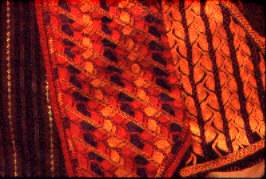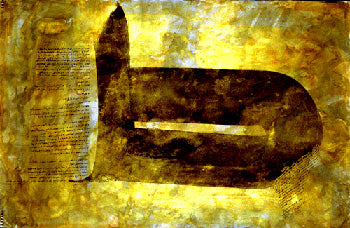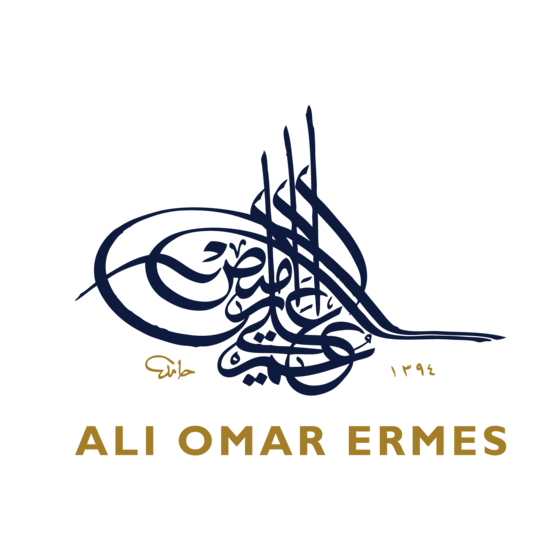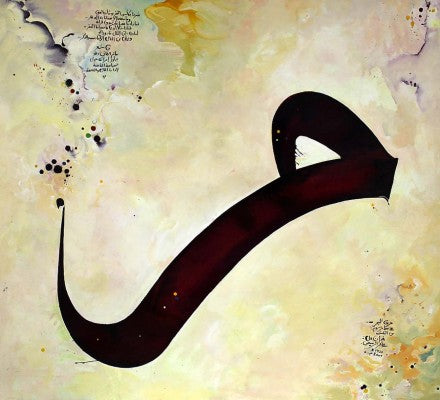The Fabric of Tradition

Written by Heather Colyer Ross
Photographed by Robert Azzi
The story of Arabian costume is an ancient one, though for the most part it is undocumented. We do know, however, that from earliest times fine cloth and beautiful adornments have been woven into the fabric of Arabian tradition.
From classical times, nearly 3,000 years ago, through the golden ages of the Umayyad and Abbasid empires, the Arabian Peninsula was near the center of the Old World's stage. Two natural resources, frankincense and myrhh, tree resins from the southern desert mountains, were much prized in the empires of Greece and Rome. Somewhat like petroleum today, they were the basis of a number of popular commodities, and – again like petroleum – they brought the Peninsula into commercial contact with the rest of the world then known. They also, for a time, brought great wealth.
Later, after the resin market had collapsed, Arab seamen boldly sailed the monsoon winds to supplant the long-established overland caravan trade network and channel the goods of East Africa and the luxuries of Southeast Asia and the Far East through Arabia's market centers to medieval Europe. The powerful trade monopoly that resulted brought fabulous textiles, perfumes and jewels to the tribes and townspeople of the Peninsula.
But influences other than history and fashion affected the development of traditional Arabian clothing. First there was the harsh reality of the desert climate, hot and – except in the humid coastal regions – extremely dry. Clothing had to protect its wearer from the sun and wind, and had to catch cool breezes while yet conserving body moisture essential for life itself. On a different plane, there was the cultural and religious injunction to modesty in behavior and dress.
The combination of these various factors resulted in clothing of practicality, simplicity and natural grace in everyday wear, with fine, often elegant and occasionally spectacular detailing on ceremonial and holiday garments. Thus the best of traditional Arabian costume is a blend of artfulness – skillful and ingenious design – with art – beautiful and intricate tailoring and decoration.
In modern times, oil wealth has swept away a great deal of traditional life. While to the Western visitor Arab clothing may appear both exotic and timeless, in fact it bears only superficial similarity today to its earlier origins. Over the past 50 years alone, for example, the introduction of synthetic fibers – and air conditioning – have led to slimmer cuts in both men's and women's attire, especially in the fitted sleeves. Men's body shirts now have both cuffs and pockets and women's dresses utilize zippers. Also, of course, men frequently wear business suits or jackets and their wives often turn to Western fashions beneath their outer cloaks.
Until recently, it was possible to find Bedouin dresses that were hand-sewn and hand-embroidered, and occasionally one would turn up which was made of homespun, locally-dyed textile. Today imports from textile centers such as Damascus and Bombay cater to the tastes of townswomen, while local tailors machine-stitch and embroider most of the tribal dresses found in the markets of Ta'if, Abha and Najran. Too often, the decoration is on a cheap and gaudy power-loomed synthetic base.
While traditional clothing has retained popularity, especially for ceremonial occasions such as wedding parties or men's traditional dancing, truly authentic old costumes have now become a rarity in the suqs of Arabia's cities. When tourists and casual souvenir hunters began buying the best remaining examples in recent years, serious collectors and devotees of traditional arts and crafts, both foreigners and Saudis, became concerned.
One influential Saudi couple working to increase awareness of this aspect of Arabia's cultural legacy, and to help preserve Saudi handwork for future generations to appreciate and enjoy, is Saudi Arabia's ambassador to the United States, Prince Bandar ibn Sultan, and his wife, Princess Haifa bint Faysal, a daughter of the late King Faysal. In Washington, D.C., last year the ambassador and his lady were hosts at a reception and fashion show for 500 distinguished guests at which models presented some 64 dresses – both the sequined, diaphanous, floating chiffon kaftans of the Arabian townswoman, and the embroidered and appliqued solid textile dresses of the Bedouin woman – all bedecked with traditional jewelry.
Shortly thereafter, 23 of the costumes, both men's and women's, were featured in a four-week exhibition at the Textile Museum in Washington, giving the city's residents and visitors a taste of the grace and glamour of Arabia's times past. A broader selection of the costumes, in an exhibition called "Palms and Pomegranates: Traditional Dress of Saudi Arabia," will tour U.S. cities beginning this November in Cambridge, Massachusetts. At the conclusion of the American tour the collection will return to Saudi Arabia for permanent display in a proposed costume museum there.
A number of features of traditional Arabian clothing are worth elaborating. These include the basic similarity of men's and women's garments, regional variations due to climate and altitude, tribal distinctions in stylistic or decorative details, and speculations on certain subtle influences which may have found their way abroad.
For both men and women, every item of traditional apparel was designed for protection against the relentless desert sun. Folds and layering were the unifying factors, both for insulation and to retain body moisture. The head was always covered, and headcloths were held in place by a practical circlet made of either cloth, leather, fiber or metal, and sometimes a combination of these. Both men and women drew the headcloth about the face to exclude dust and blowing sand and to shade the eyes from glare.
There was very little difference between the cut of garments worn by men and women in traditional Arabia. It was usually the textile or the style in which the garment was made which indicated whether it belonged to a man or woman. Even today, the cloaks (bisht for men and 'abaya for women) look quite similar in shape. Women wear the 'abaya draped from the crown of the head and men wear the bisht hanging from their shoulders.
The basic traditional garment, the bodyshirt, is generally known as thawb for men. A variation of the thawb, with large, open sleeves, is called a shilhat. The bodyshirt probably took its final, classical shape long ago, and has survived because it is the ideal garment for all people at all times, being comfortable, modest and flattering.
In the Bedouin lifestyle, sitting cross-legged or reclining on carpets and bolsters is the form, and loose and unrevealing clothing is essential. Although the head covering, the outer cloak and the bodyshirt all no doubt evolved before the revelation of Islam, Islam has preserved these ancient costumes and left an indelible mark upon their styling. Although rich and colorful textiles were traditionally worn by menfolk in Arabia until early this century, for example, particularly devout Muslim men generally preferred to wear white or discreet shades of gray, blue or green.
The proportions of the bodyshirt's cut vary in different regions of the Peninsula according to temperature and terrain. The largest garments are from the Najd, the hot central region of Arabia. They have enormously wide sleeves which catch a breeze, and deep folds to trap body moisture. As large and seemingly shapeless as this women's festive garment appears, it retains all the basic pattern components, including the underarm gusset, which in a Western garment is a purely functional segment that ensures ease of movement when the sleeves and the bodice – the portion of the dress above the waist – are form-fitting. In the Najdi dress, this triangular segment is usually fashioned from a contrasting, alternative textile, or it is embellished with braid, metal – thread work, sequins and embroidery.
By contrast, women living in the Sarawat Mountain range wear almost form-fitting clothing. This region of highlands reaches from the southern part of the Hijaz in western Arabia, extending parallel to the Red Sea through the 'Asir district in the southwest to the peaks of neighboring North Yemen. In this more temperate land, dresses are slimmer cut and the sleeves are fitted, yet the garment still drops easily over the head and is full enough to be worn by a woman throughout her pregnancy.
Townswomen of lowland coastal Hijaz, living in the urban centers of Makkah, Medina and Jiddah in times past, wore unique Arabian costumes with exotic overtones which became the mark of their regional dress. Many gowns had sleeves so closely fitted that the lady had to be stitched into them.
The colors of the dresses of eastern Arabia, on the opposite coast of the Peninsula, were influenced by the shades worn in India, where many textiles and embroideries were traditionally custom-made for Gulf women. Sheer base cloths of many colors were richly worked in gold thread. For the most part, Bedouin women, semi-Bedouins and townswomen all wore strikingly different dresses in times past, and those dresses were different again depending on whether the wearer came from rural Hijaz, Asir, the Najd or eastern Arabia.
Western visitors to the Peninsula often focus on the fact that the Arab women they encounter in the streets and markets are uniformly draped in black. They fail to realize that in the privacy of their homes women indulge in vividly hued textiles often with the additional sparkle of metalthread work, sequins, braid-work, appliqué and embroidery. The black cloak is drawn over these attractive and colorful, dresses in public to preserve modesty. Not too many years ago, in fact, custom permitted women to venture forth in cloaks which were richly embellished with gold thread, albeit in textiles of conservative colors. Although Bedouin and semi-Bedouin women of an earlier time generally wore locally-dyed indigo cloth, their garments were vivid with silk patches, colorful embroidery and other embellishments such as brass, silver, shells and mother-of-pearl.
Today dress seams and pattern segments are still reinforced and outlined with embroidery. Embroidery motifs reflect an Islamic precept which discouraged the representation of the human form and led to the development of arabesque, an Islamic form of decorative art. Dresses display arabesque's geometric shapes and flowing curvilinear designs, sometimes incorporating stylized trees, plants and flowers.
The differences in placement of appliqué and embellishment once indicated tribe and sub-tribe of the wearer. In dresses from eastern Arabia, for example, all outer edges are embroidered with gold metal thread. Tiny "seed" beads are used lavishly on garments worn along Arabia's west coast, and large silver balls enhance sleeve cuffs from central Arabia.
In the south dresses are somewhat shorter, and the long full-cut trousers which are an essential part of both men's and women's traditional dress become a visible part of the costume. Alois Musil, one of the few early Western travelers in Arabia to give any worthwhile costume descriptions, noted that the northern Ruwala tribe's womenfolk wore homemade gowns much longer than the wearer's body. These dresses were sparsely embroidered, if at all, and took their color from bright, hand-woven belts which were used to hitch up the lengthy skirts in a deep fold at the waist, to provide freedom of movement.
Bedouin dresses among other tribes are remarkable for their huge, wide sleeves with deep lappets, or flaps, reaching almost to the hemline. Women customarily knotted the ends of these sleeves together behind their backs to free their hands for work. Such dresses bear a remarkable similarity to the costumes of Western medieval women and modern ecclesiastical dress, perhaps due to European contacts with the East in the time of the Crusades.
In the Hijaz region one Bedouin embroidery stitch is reminiscent of the "spider's web" stitch found in Western embroidery. It is possible that this stitch originated in the Arabian Peninsula or India, and found its way to the West by way of Islamic Spain. Another such link may exist in certain jewelry patterns that exist both in Arabia and in America's Southwest: They may have reached the New World via Spain's Mexican connection.
The traditions of Arabian costume are rich and ancient. Exhibitions of collections such as the series this autumn in the United States, and the museum proposed in Saudi Arabia, will help to preserve priceless examples of the craft. But much of the history and lore associated with regional and tribal variations, and much knowledge of the techniques and symbolism of embroidery patterns, are today at risk. It would be a worthwhile work of cultural preservation to assemble competent research teams – ideally of female anthropologists – to interview those elderly women among the Peninsula's Bedouins whose memories are the last storehouse of this unique folk heritage. Soon those memories will be lost to their modern granddaughters, and to future generations.
Heather Colyer Ross, an Australian, has collected, exhibited, lectured and written about Arabian-Peninsula Bedouin jewelry and costume for some 15 years. She is the author of three books including The Art of Bedouin Jewellery and The Art of Arabian Costume, published by Arabesque, Fribourg, Switzerland.
This article appeared on pages 21-29 of the September/October 1987 print edition of Saudi Aramco World.
Leave a comment
Also in ART & CULTURE

2e Édition De Fikra “la Créativité Est Le Pilier De L’entrepreneuriat”
Vincenzo Nesci, l’un des principaux promoteurs de la 2e édition Fikra, lors de cette conférence internationale a abordé «la création d’entreprise et l’entrepreneuriat». Selon le directeur exécutif de Djezzy, ces derniers, «doivent être réalisés dans des conditions d’optimisme et de créativité pour permettre un réel essor dans les domaines commercial, industriel et créatif»



